Meet the Neighbors: Multiple Wildlife Species Share an Urban Den Site in Cleveland, Ohio
The red fox, Vulpes vulpes, has the most widespread range of any wild canid, or member of the dog family. It is naturally found throughout the Northern Hemisphere, living as far north as the Arctic Circle and as far south as North Africa and India (Canid Specialist Group, n.d.). As humans have continued to urbanize once-natural landscapes, this species has become an urban adapter in the sense that it will readily colonize and persist in cities (Moll, 2022). Its larger canine counterpart, the coyote (Canis latrans), is also present in these urban landscapes, but is less associated with areas of high human presence. Regarding competition between these two carnivores, coyotes dominate, and may even cause red fox mortality (Moll et al., 2018). As part of the Research Experience and Apprenticeship Program (REAP) through the Hamel Center for Undergraduate Research, I traveled to Cleveland, Ohio, to learn more about wildlife such as red foxes in urban systems.
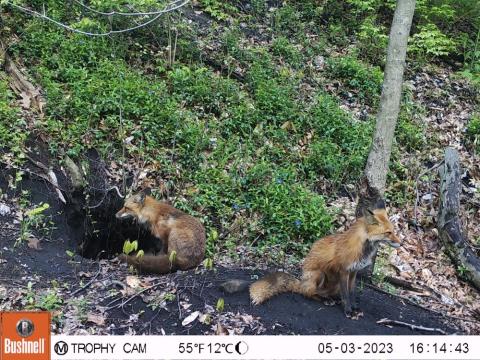
Image 1: Adult red foxes outside the den in May 2023.
One project I took on was to analyze data from a red fox den site in the Cleveland Metroparks. Generally, dens are important to mammals such as red foxes for sheltering their vulnerable young offspring, thereby contributing to the survival of successive generations (Allen & Kritzer, 2023). There has been documentation of numerous species occupying shared den sites, and I was interested in investigating such phenomena in urban environments. This particular den, which I visited with Ph.D. student Taylor Readyhough of the University of New Hampshire, and Cleveland Metroparks wildlife ecologist Jon Cepek, had been used by multiple species over a three-year period. My goal was to determine which species were using this den, and the specific time periods in which they were occupying it throughout the year. This analysis will provide insight into the types of interspecific interactions and den usage that occur in urban environments and could inform policies regarding which types of land to protect. For example, areas that provide habitat for multiple species could be left intact when expanding business or residential development. The Cleveland Metroparks system exemplifies this idea, because it consists of intact natural areas and forests surrounding an urban city center. These areas have been protected from further urban development, leaving them open for use by wildlife.
Using Wildlife Cameras to Monitor Den Activity in the Cleveland Metroparks
The Cleveland Metroparks maintain a network of about 200 cameras spread throughout the “emerald necklace” of reservations ringing the city. In total, these reservations comprise about 24,000 acres of natural space that is predominately forested. These cameras were installed in 2015 and 2016 and will continue to monitor wildlife indefinitely. Their purpose is to identify and monitor the wildlife species and populations present in the Metroparks, with a particular interest in rarer species such as bobcats (Lynx rufus) and the red fox’s fellow canid, gray foxes (Urycon cinereoargenteus).
Data for my project was gathered using photos and videos captured by wildlife cameras deployed at the den site, in the Mill Stream Run reservation on a steep slope adjacent to a road in a suburban neighborhood. Cleveland Metroparks wildlife ecologist Jon Cepek set up three cameras at this location as a side project to complement the greater camera project. Between March 25, 2021, and June 13, 2023, these cameras collected image and video data from the den site. The cameras were programmed to take bursts of three photos, followed by one short video, and were activated by motion. The one Bushnell-brand camera took a twenty-second video, and the two Reconyx-brand cameras (which were deployed at separate times) took a five-second video. There were some gaps in data collection over the three-year period because multiple cameras were used and were not as consistently monitored as those used for the larger project throughout the Metroparks. During all other time windows, at least one of the wildlife cameras was operational and recording activity at the main den entrance.
I arrived in Cleveland in July 2023, so I was not present while the cameras were actively recording. I was responsible for compiling the existing data from this den site, which was stored on SD cards. I transferred the photos and videos from these cards onto a USB drive, and then analyzed each photo and video using Timelapse 2 software (Greenberg, 2021). This program allows for efficient tagging of photos by species, and has other notable features. Tagging the images and videos this way allows for synthesis of the data in a format that is more useful for analysis.
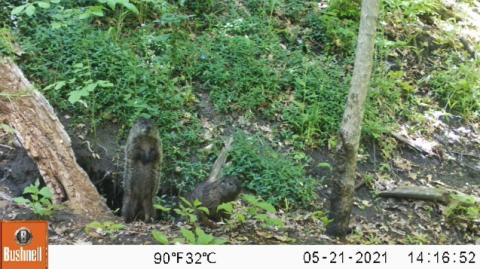
Image 2: The two resident woodchucks in May 2021. One is standing alert on its hind legs, while the other crouches to the side.
As I processed each image or video, I recorded the species that was present, and checked off another field if it was in the den. All of this was accomplished using the Timelapse software. Any animal seen entering or leaving the den, with its body mostly in the hole, was qualified as “using” the den, even if they may not have been living in it. This allowed me to identify which animal species were passing through the site and distinguish them from those that were actually entering or using the den. This distinction was vital to analysis, because one of the main purposes of this research was to explore the way in which a den complex created by one species could be used by other species.
Based on a qualitative examination of the structure of the holes within the den complex, our team concluded that a woodchuck (Marmota monax) likely constructed the den originally. The den consisted of a relatively large, round hole in some dark earth on a steep hillside, along with a smaller hole farther up the slope. The area was wooded, with some understory plants around the den entrances.
Findings of Den Use by Four Species Over Three Years
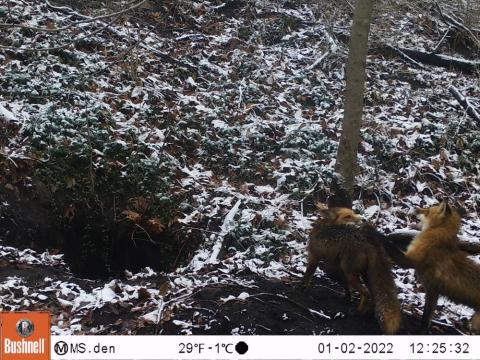
Image 3: Possible courtship behavior displayed by two red foxes in January 2022.
After quantifying all the detections by species and month, my findings suggest that at least four different species definitely used the den: red foxes, raccoons (Procyon lotor), Virginia opossums (Didelphis virginiana), and woodchucks. In spring 2021, at least two woodchucks lived in the den, and their occupation continued into early summer; red foxes denned at the site that same spring.
In late fall 2021, I observed red foxes digging and entering the den several times, but they would not have been living there at that time of year without young. Though they may visit the area, red foxes do not typically take shelter in dens once the young from the previous breeding season have been reared (Allen & Kritzer, 2023). An opossum also appeared to be using the den a couple of times during December 2021, but it may have been to avoid inclement weather. Two red foxes returned to the site in January, and I observed what I concluded was courtship behavior. I recorded at least two raccoons living there during winter 2022 into spring, and during a similar time frame, a woodchuck lived there as well. In May, the latter was seen gathering leaves, suggesting its home was most likely still the nearby den. Red foxes entered the den in April 2022, but I made no observations of offspring. None of the data showed two species together in an image using the den, but I did observe temporal overlap in occupation by raccoons and woodchucks during late winter and early spring 2022.
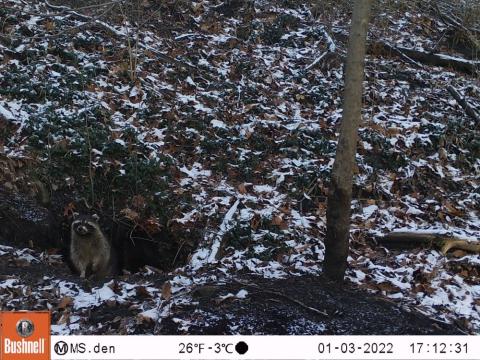
Image 4: A racoon emerging from the den in January 2022.
The raccoons seemed to continue their occupation of the den into summer 2022, and I observed an opossum entering several times in August 2022. The woodchuck was less present on the cameras, but it may have used the other hole for its entries and exits while still living there. In early fall 2022, a red fox was digging in the den, and it appeared that the opossum had taken up residence. The red foxes showed marking behaviors such as raised-leg urinations around the den in October 2022, as did a coyote that left excrement by the entrance. This is direct evidence of the two species’ overlapping home ranges, and their efforts to stake their claims to this site. Notably, on October 16, the coyote came to the site just twenty minutes after the red fox departed, and it was at this point that the larger canid defecated at the site. Although this footage indicated the presence of both species at the site, the coyote was not seen in the den during this time and therefore did not qualify as using the den.
In fall 2022, I still observed the raccoons to be in residence. As one of the gaps in camera data occurred between December 2022 and March 2023, it is unknown which species visited or used the den. I noted that a woodchuck, raccoons, and red foxes all used the den in spring 2023.
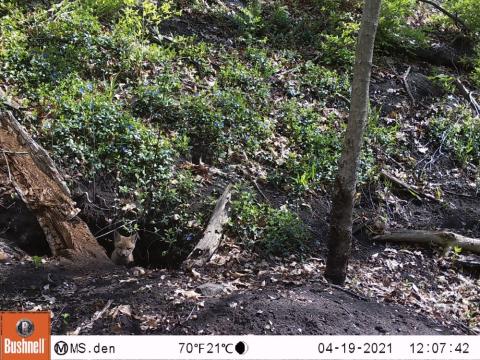
Image 5: Fox kit peering out of the den in April 2021
At least one baby fox kit was born in 2021. Coyotes had been digging in the den earlier in the spring, but never entered it during the time that the fox kit was present. Red foxes denned at the site again in spring 2023, but it is unclear whether they were the same parents from 2021, or completely unrelated individuals. They produced at least one kit.
During both years that red foxes gave birth in the den, it is unclear whether their offspring survived. Coyotes were also seen frequenting the area in both 2021 and 2023, so it is possible that they killed the fox kits. There is a chance that the red fox parents relocated their young in response to coyote presence, but that is unconfirmed by the available image data.
On April 19, 2021, the kit spent a significant amount of time outside the den entrance and barked frequently. Because it was seen alone, and appeared that it might have been distressed, there is a real possibility that it was killed by a coyote. In 2023, the fox parents appeared to be more present at the den site, watching the kit as it played and bringing back prey such as flying squirrels (Glaucomys volans). This kit was also seen in the footage over a longer period of time: from April 8 to April 26, 2023, versus just April 18 and 19 in 2021. Interestingly, there was more coyote presence at the den site in April 2023 than April 2021, which could possibly explain why the adults appeared more vigilant in guarding the area.
Biodiversity Impacts of Intact Habitat within Urban Landscapes
The research done at this location in Cleveland provides insight into the diversity of species that may use a single den site during a relatively short period of time. It supports the idea that a complex created by woodchucks can provide shelter for foxes, raccoons, opossums, and possibly other wildlife. It also highlights how competing species such as red foxes and coyotes may have overlapping home ranges, and the way in which the presence of certain species such as woodchucks can provide habitat for other animals.
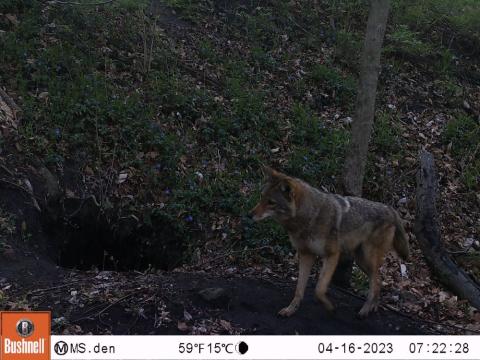
Image 6: A coyote at the den site in April 2023, during the date range that a red fox was also present there.
Notably, some of these species may have been using the den complex at the same time. This is not necessarily unusual, since animals that den in the same complexes could logically be there simultaneously. For instance, studies in Britain found red foxes living in badger setts, both with and without the badgers in residence (Soulsbury et al., 2010). In Cleveland, both a raccoon and a red fox kit were seen exiting the den on April 26, 2023, suggesting simultaneous occupation. This type of sharing of a den by multiple species has also been documented in less urbanized areas, such as New Hampshire. A study of a gray fox den in Strafford County documented gray foxes, skunks, opossums, and woodchucks using the den together in various combinations (Allen & Kritzer, 2023). Unlike the Cleveland den site, this area was more heavily wooded, and had a lower density of houses (Allen & Kritzer, 2023).
Understanding the way in which multiple species may make use of the same den site can inform the study of interspecific interactions by wildlife ecologists. When a site is identified as being important to the success and reproduction of multiple species, it should be more highly considered for preservation if new development is encroaching. It is possible that den sites in urban habitats experience greater occupancy by multiple species because there are fewer undeveloped areas. In planning development, it is important to leave some areas in a wooded or natural state, because even small amounts of these lands could increase biodiversity. In areas increasingly fragmented by development, it is important to leave ecological relationships intact, and conserve wildlife-rich habitat segments to avoid causing local extinctions or isolating populations.
I am working toward analyzing and quantifying the data set, with the ultimate goal of writing a “Nature Note” publication for the Urban Naturalist journal by the end of the academic year. Being able to work on projects involving wildlife, particularly canids, is an integral step in my education and career goals. My dream is to be able to work to allow eastern timber wolves (Canis lupus lycaon) to recolonize areas of their former range in the northeastern United States and New York. In Cleveland, I learned a lot about human-wildlife interactions. While the areas wolves may come back to would not be as urban as Cleveland and the surrounding Metroparks, they would still encounter a human-altered landscape. If they were to be successful in returning to parts of their former range, people would have to learn how to be tolerant, and coexist with them. If I were to further pursue research with canids, as an undergraduate or beyond, understanding the dynamics between these competing species, especially if wolves were also present on the landscape, would be vital.
I would like to thank my mentor, Dr. Remington J. Moll, for providing me with the opportunity to study wildlife in Cleveland, Ohio, in summer 2023. I greatly appreciate his commitment to my learning and research goals. Thank you to Ph.D. student Taylor S. Readyhough for taking me to Cleveland, teaching me, and supporting me during this research process. I am especially grateful to Cleveland Metroparks wildlife ecologist Jonathan D. Cepek for initiating the collection of this data and allowing me the freedom to analyze it through this project. Finally, I would like to thank the Hamel Center for Undergraduate Research for the amazing opportunity to conduct research at such an early stage in my education, and to Mr. Dana Hamel for funding my summer research experience.
References
Allen, M. L., & Kritzer, J. P. (2023). Observations of gray fox Urocyon cinereoargenteus (Schreber, 1775) (Mammalia: Carnivora: Canidae) denning behavior in New Hampshire, USA. Journal of Threatened Taxa, 15(8). https://doi.org/10.11609/jott.2023.15.8.23631-23826
Canid Specialist Group. (n.d.). Red Fox Vulpes vulpes. Canids.org. https://www.canids.org/species/view/PREKLP237241#:~:text=Geographic%20Range%20Information,steppes%2C%20India%2C%20and%20Japan.
Greenberg, S. (2021, September 26). Timelapse User Guide. Saul Greenberg. http://saul.cpsc.ucalgary.ca/timelapse/uploads/Installs/Timelapse2/Timelapse2Manual.pdf
Moll, R. J. (2022, December). Urban Wildlife. Durham, NH; Demeritt Hall.
Moll, R. J., Cepek, J. D., Lorch, P. D., Dennis, P. M., Robison, T, Milspaugh, J., & Montgomery, R. (2018). Humans and urban development mediate the sympatry of competing carnivores. Urban Ecosyst 21, 765–778. https://doi.org/10.1007/s11252-018-0758-6
Soulsbury, C. D., Baker, P. J., Iossa, G., & Harris, S. (2010). Red Fox (Vulpes vulpes). In S. D. Gehrt, S. P. D. Riley & B. L. Cypher (Eds.). Urban carnivores: Ecology, conflict, and conservation (pp. 62–75). John Hopkins University Press.
Author and Mentor Bios

Caroline E. Savage will graduate in spring 2026 with a bachelor of science degree in wildlife and conservation biology. Originally from Exeter, New Hampshire, she is a member of the University Honors Program and is also a Hamel Scholar. Caroline began working for Dr. Rem Moll’s lab in October 2022, processing New Hampshire wildlife camera images. She continued this research under Dr. Moll’s mentorship through the Research Experience and Apprenticeship Program (REAP) offered by the Hamel Center for Undergraduate Research. This project taught Caroline about the close proximity in which coyotes and red foxes live, the possibility of this affecting survival of fox offspring, and that it is not uncommon for different species to inhabit the same den simultaneously. She also learned how long and painstaking it can be to process raw data , while also being incredibly rewarding in drawing conclusions that would otherwise not have been possible. She especially enjoyed looking through photos and videos of the fox kits and parents, and the other species that visited the den site. She decided to submit to Inquiry while preparing a research paper to send to the Urban Naturalist. Caroline plans to pursue graduate school but may take time first to gain more work experience. Doing this research provided insight into different wildlife issues and the careers of those working on them, and gave her the opportunity to connect with many people in the wildlife field.
Remington Moll is an assistant professor in the Department of Natural Resources and the Environment at the University of New Hampshire. He started teaching at UNH in 2020 and specializes in wildlife ecology and management. Dr. Moll did part of his Ph.D. work in the Cleveland Metroparks in Ohio, which led to this collaboration for Caroline’s project. He is really interested in urban ecology and how certain species can coexist alongside humans in built environments. He has had the pleasure of mentoring several students who received REAP grants through the Hamel Center; this is his first time mentoring an Inquiry author. Dr. Moll is very glad Caroline was able to travel to Cleveland in summer 2023 with a Ph.D. student in his group, Taylor Readyhough, where they got to join in several on-the-ground field projects in the urban park system. He says that Caroline did a wonderful job being flexible and contributing to the research project.
Copyright 2024 © Caroline Savage
